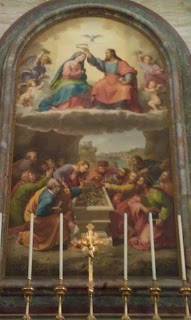Holy Week celebrates our faith in its most concentrated form. The essence of what we believe and who we are is captured in the events of that week and the Scriptures that recall them. Our time in Jerusalem allowed us to walk through the events of this most holy week.
We start on the Mount of Olives at the Church of the Pater Noster where Jesus taught his followers how to pray. The Mount of Olives, even in Jesus' time, was a graveyard and the place where the unclean lived.
People, who because of illness or other reasons that made them ritually impure, were not allowed to come into the city and would have been restricted to this area. None of the Pharisees or Scribes of the Law would have ever visited them for fear of becoming unclean themselves. Jesus came to those whom nobody considered worthy of teaching and taught them how to pray to God as "Abba" Daddy.
The Church that is built on this site has The Lord's Prayer written in almost every language known to man. Two of the priests (left) in our group are from New Zealand and they were excited to find the Lord's Prayer written in Maori, which is the native language of New Zealand.

I was equally excited to find the Lord's prayer written in Cherokee, but it was also written in the language of the Samaritans, the Basque separatists of northern Spain, Gaelic, Ojibway and even Sanskrit (see above). It seems that there is no land that cannot use these words to pray.

Assisting us at Mass in the Church of the Pater Noster was a nun who knew St. Therese of Lisieux's older sister. (Right) She has spent the last 50 years in the Holy Land welcoming pilgrims and inviting them to reflect on the words of this prayer.
It was also from the Mount of Olives where Jesus began his triumphal entry to Jerusalem that we recall on Palm Sunday. As Jesus approached the city from the east with the rising sun, there would have been great expectation that the Messiah had come to free the people from the oppression of Roman rule. He would have walked through the Kidron valley (below) to approach the gates of Jerusalem.
 |
| Kidron Valley |
Instead of overthrowing Roman rule, Jesus invited his Apostles to join him in the upper room (below) of a Roman Tavern for a meal.
 |
| The Upper Room at Last Supper |
This was the same room where the Lord appeared to his disciples after his resurrection and where St. Thomas declared, "My Lord and My God" after seeing Jesus risen from the dead.
From here we crossed back over the Kidron Valley to the Garden of Gethsemane where Jesus prayed with his disciples that he might not have to undergo the suffering of the Cross.
 |
| Garden of Gethsemane |

After Jesus was arrested in the Garden, he was taken by the soldiers across the valley to the house of Caiaphas the High Priest.
It was in the courtyard of this house that Peter denied that he even knew Jesus.
| Icon of Peter Denying Jesus with Rooster |
 |
| Statue of Peter's Denial |
We celebrated Mass in the courtyard where Peter denied Jesus and recalled the times when we have denied Jesus in our own words and actions.
 |
| Altar at the Courtyard of Denial |
The penitential act that we recite together at the beginning of Mass was especially meaningful this day.
"I confess to almighty God
and to you, my brothers and sisters, that I have greatly sinned,
in my thoughts and in my words,
in what I have done and in what I have failed to do..."
Peace and Goodness,
FD


































